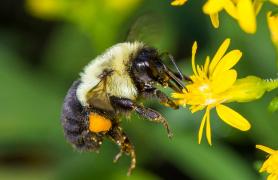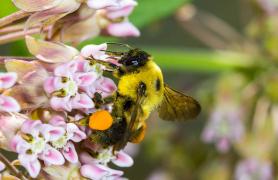As a retired nutritionist, Leslie Limberg spent her career advising patients on the necessity of eating properly. Even in retirement, nutrition continues to play a big role in her life, but her patients have changed considerably.
Now, from her home on 5 mostly wooded acres in New Melle west of St. Louis, Limberg spends her spring preparing for the nutritional needs of nature in general and ruby-throated hummingbirds in particular.
“Once a nutritionist, always a nutritionist,” Limberg said. “I love to nurture and feed. When these hummingbirds started knocking on the door, which they do, they came to the right house.”
Starting in early to mid-April, Limberg will begin seeing the first of her feisty, flighty little guests from down south. There’s one or two at first, but at the peak of the season, she’ll play host to as many as 60.
Why Hummers
In Missouri, and virtually anywhere throughout its breeding range in the eastern United States, the ruby-throated hummingbird’s annual arrival strikes joy in the hearts of those who see it, according to Missouri State Ornithologist Sarah Kendrick.
“People love feeding hummingbirds,” Kendrick said. “They love these birds a lot. They’re itty bitty and beat their wings over 50 times per second, and they migrate thousands of miles twice a year — I mean, what is not cool about that?”
In the case of the ruby-throated hummingbird, “itty bitty” means 3¾ inches long — from the tip of its beak to the end of its tail — and a top weight of roughly ¼ ounce — comparable to the weight of three dimes. It makes use of its blink-of-an-eye wing speed to make its annual trek from its winter home in southern Mexico and most of Central America to its spring and summer breeding grounds throughout North America, mostly east of the Rocky Mountains, Kendrick said.
“It is the only eastern-nesting hummingbird in the United States,” she said. “There are about 10 species that are found in the southwest or along the west coast. Sometimes we can see those species here if an individual is blown off course during migration.”
The hummingbird’s size and wing speed also make it capable of performing feats of flight that are impossible for other birds, which endears it to those who see it, Limberg said.
“They are like helicopters, they can go up and down — straight up and down,” she said. “They can go backwards, forwards, to the left, to the right, just like a helicopter.”
Feeders First
In an effort to attract hummingbirds, the first step is also the most intuitive — putting out a hummingbird feeder. While Pinterest overflows with plans for making elaborate hummingbird feeders, commercially made feeders are relatively inexpensive. Unlike the seed used for most bird feeders, hummingbird feeders use a simple sugar water mixture, Kendrick said. (See Nectar Notes and Feeder Facts below.)
“If you put out a feeder and there are hummers in your area, they’ll use it, but you may have to give them some time to find it,” she said.
While hummingbirds are attracted to red, the sugar water doesn’t need to be red, and the dye can be harmful to the birds, Kendrick said.
“Most feeders are red, so the birds will be attracted to it already. Red native plant species also help to attract the birds to your yard,” she said.
Limberg’s hummer hotel, which began with a single “old feeder from a garage sale,” now consists of up to 10 feeders at the peak of the season.
“We moved in here in 2001, and we put up a feeder, why not?” she said. “And the next year, we put up two. And it’s just multiplied like that.
“The second week of April is a religious time around here. April 15 is the cutoff point where we will have at least one or two.”
Although most hummingbirds have begun their southward trek by early October, Kendrick recommends leaving feeders in place through mid-October to help stragglers. Leaving the feeders up an extra week or two after you think the last birds have moved through is a good idea, she said.
“There may be some late birds that it may help out,” she said. “And what’s the harm in leaving them up a little bit longer?” Contrary to at least one hummingbird misconception, having the feeders out later at the end of the season does not tempt hummingbirds to delay their migration.
“Birds are prompted to migrate by other cues, including day length,” she said. “They know when it’s time to go. A feeder isn’t going to keep them here.”
Success has come with a price for Limberg. Playing host to such hyperactive houseguests requires regular attention, which results in the purchase of enough sugar to raise eyebrows at the local grocery store. From the arrival of the first hummers in April through the final departure in October, Limberg goes through approximately 135 pounds of sugar.
“In the middle of summer, they will empty a 20-ounce feeder in about five hours,” she said.
Habitats Help
If putting out feeders is the equivalent of putting out the welcome mat for hummingbirds, then improving the habitat around your house with native plants is the equivalent of putting out a breakfast buffet (See A Breakfast Buffet for Hummingbirds).
“All birds, including hummingbirds, are more likely to visit and return to a yard that provides the things that they need, including food, water, and shelter. The best way to achieve all three is through feeders and native plants,” Kendrick said. “If you want to attract hummingbirds, plant red native plants — most natives are perennials, so they’ll be long-lasting and come back the following year.”
Developing a hospitable habitat is something Limberg, who has been a Master Naturalist since 2005, has taken to heart. In 2011, she was awarded the St. Louis Audubon Society’s “Bring Conservation Home” Platinum habitat designation. The habitat she’s created on her property has also been recognized by the National Wildlife Federation and Xerces Society.
In addition to providing nectar, native plants also attract insects that become additional nutrition for hummingbirds, she said.
“They eat gnats, mosquitoes, spiders, aphids, flies, caterpillars, leaf hoppers,” she said. “They eat pollen — of course nectar as everybody knows — beetles, a little tree sap, if nothing else in weather like this.”
In maintaining a habitat-specific area, sometimes less is more, she said.
“We don’t take out the weed whacker until the end of April, because there’s little insects in the pith of the large goldenrod stalks and the other fat stalks, ironweed or whatever,” she said. “It’s a messy garden, but it’s all very deliberate.”
While nectar is important to hummingbirds, having the supply of insects that come with native plants, shrubs, and trees is also important for nestlings, Kendrick said.
“Hummingbirds feed insects to their young after the first few weeks,” she said. “Adults regurgitate their food for nestlings younger than that, which includes both nectar and insects, but the young also rely heavily on a diversity of insects.”
One For All
While hummingbirds take top billing, preparing a landscape for them also makes an inviting area for other bird species and wildlife in general, Limberg said.
“You can’t just live for hummingbirds,” she said. “You live for hummingbirds and butterflies. And then you live for hummingbirds, butterflies, and pollinators, so you get everybody else in the mix.” The result, she said, is a front row seat to the circle of life.
“Everybody’s in the game together,” she said. “You can’t take care of one without taking care of the others, because they all interact, and they’re all neighbors.”
Did you know?
- Actual size 3¾ inches
- Weight ¼ ounce (comparable to the weight of three dimes)
- The ruby-throated hummingbird is Missouri’s only common hummingbird species.
- Hummingbirds are important pollinators for many species of plants that require a long-billed pollinator.
- Nesting begins in mid-May. In summer, you can see broods traveling and foraging with their parents.
- Our hummingbird numbers are greatest from August to late September during migration.
- By October 10, most ruby-throated hummingbirds have migrated south of Missouri.
- Actual egg size Females lay 1–2 broods each summer, with 1–3 eggs per brood.
- Actual nest size Tiny nests are built to expand as the young grow — typically with spider silk and down from thistle or dandelion.
Nectar Notes and Feeder Facts
For many people, attracting hummingbirds begins and ends with putting out a hummingbird feeder. While commercially produced nectar is available, most of it contains red dye and making nectar at home is simple and much cheaper.
A mixture of one part table sugar dissolved into four parts of boiling water is the recipe for hummingbird nectar. Other sweeteners, such as honey or artificial sweeteners, are harmful to hummingbirds and should not be used. Allow the heated sugar water mixture to cool before placing the feeder.
If you’re fortunate to draw hummingbirds in large numbers, your challenge will be to keep the feeders full. If the attendance at your feeder is more modest, you will need to replace the nectar in the feeder, said MDC State Ornithologist Sarah Kendrick.
“Generally, feeders are out when it’s hot, and the water can get kind of opaque or cloudy due to bacteria,” Kendrick said. “You want to replace the sugar water every week if it’s really hot, or every two weeks if the weather is cool before it can become harmful. Wash feeders with a diluted vinegar solution and a bottle brush before refilling.”
- Sometimes disputes arise as one hummingbird will aggressively try to defend a particular nectar feeder. Hanging several nectar feeders in various locations, where one feeder can’t be seen from another, can lessen the competition for a single feeder.
- Ruby-throated Hummingbirds in Missouri is available free for Missouri residents. Order a copy from pubstaff@mdc.mo.gov or by calling 573-522-0108. Provide the publication title and your shipping address.
A Breakfast Buffet for Hummingbirds
There are many native plants recommended for attracting hummingbirds. The Missouri Prairie Foundation’s Grow Native! Website (GrowNative.org) has developed a top 10 list of hummingbird friendly natives.
MDC’s Native Plants for Your Landscape includes a suggested landscaping plan for attracting hummingbirds. It is available online at short.mdc.mo.gov/Zc8. All plants have specific requirements when it comes to the amount of sunlight, moisture, and soil type needed to thrive. Make sure to know your resources before buying and planting natives.
- Cardinal flower
- Copper iris
- Coral honeysuckle
- Crossvine
- Indian pink
- Jewelweed
- Red buckeye
- Royal catchfly
- Trumpet creeper
- Wild columbine














Also In This Issue


And More...
This Issue's Staff
Editor - Angie Daly Morfeld
Associate Editor - Larry Archer
Staff Writer - Bonnie Chasteen
Staff Writer - Heather Feeler
Staff Writer - Kristie Hilgedick
Staff Writer - Joe Jerek
Art Director - Cliff White
Designer - Les Fortenberry
Designer - Marci Porter
Photographer - Noppadol Paothong
Photographer - David Stonner
Circulation - Laura Scheuler






















